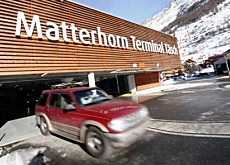Are old ski lifts condemned to history books?

Plans to dismantle the last two remaining chairlifts of their kind have met with protest from heritage groups and nostalgia buffs decrying the end of an era.
They say these wooden lifts should be recognised as cultural assets and kept in operation, in the same way 100-year-old steamboats have remained in service on Swiss lakes.
A ride aboard the “nostalgic chairlifts” either in the resort of Kandersteg in the Bernese Alps or in the Jura Mountains near Solothurn is a short, but memorable journey.
Sitting sideways and suspended only a few metres above the ground, passengers can be forgiven for feeling they are “floating by” mountains and meadows, as promised in the Kandersteg brochure.
Yet, the owners of the nearly 70-year-old Oeschinensee lift in the Bernese resort are in the process of shutting it down for good. Work has begun on the installation of a multi-person gondola to replace it. The Weissenstein company near Solothurn plans to follow suit.
Not only will the new, closed-in lift double capacity, but the annual operating costs will be considerably lower than the price tag of maintaining the old chair system, which includes ensuring it meets the latest safety standards.
The Swiss government has sent out mixed signals. The Federal Heritage Commission has recognised the Oeschinensee chairlift as a monument of national importance, while the transport authorities have issued a licence for the new gondola.
With construction well advanced, the Swiss Heritage Foundation – a non-governmental organisation – stepped in last month and issued a formal appeal to put the work on hold.
Unique history
The heritage society argues that the two facilities represent “a unique part of Switzerland’s mountain lift history” and insists the authorities have not done enough to clarify the possibility of keeping them operational.
The main owner of the Oeschinensee chairlift, David Wandfluh, told swissinfo he would withhold comment until the matter was settled.
But for amateur historian and ski lift collector, Jakob Schuler, the old system is a reminder of the pioneering days when there were countless small manufacturers churning out a wide variety of designs.
The Austrian-based Doppelmayr/Garaventa Group is now thought to control more than half of the worldwide market.
“Lifts are mass-produced and they are all the same across Europe and in North America. They don’t have any unique characteristics as did earlier ones,” Schuler told swissinfo from his home that doubles as a shrine to old ski lifts.
Uplifting belt
The first Swiss ski lift was installed in Davos in 1934. The oldest piece in Schuler’s remarkable collection of T-bars, chairlifts, cables and clamps dates back to 1941. The most unusual object is a leather belt that skiers had to wear in order to attach themselves to the lift.
“The authorities should create a special law to allow the operation of old ski lifts for a few days each year, like steam trains which aren’t run everyday but only occasionally at the weekend,” Schuler explained.
To this end, the National Heritage Foundation would like to see the creation of a non-profit organisation to safeguard what’s left of Switzerland’s mountain lift history.
The idea has won over Schuler and a handful of like-minded enthusiasts across Switzerland who have already formed a loose association of supporters.
“The Oeschinensee and Weissenstein lifts are the last two remaining facilities of their kind and when they are dismantled there will be none left that are worth preserving,” Schuler lamented.
But amateur photographer, Markus Klopfenstein, who travelled to Kandersteg to take photographs he will turn into postcards, is more realistic.
“The waiting times for the old lift are too long, and it will cost millions to maintain,” he told swissinfo. “You don’t expect the people of Zurich, for instance, to still be riding around in trams from the 1930s.”
swissinfo, Dale Bechtel in Kandersteg
According to Switzerland’s mountain lift and railway association, there are 650 companies in the sector, which operate 2,400 lift facilities.
They generate annual turnover of about SFr840 million of which 84% is done in the winter season.
They transport more than 300 million passengers – mostly skiers – a year.
Companies invest around SFr200 million annually in maintaining and upgrading their stock.
No aerial tramway goes higher in Switzerland than the one that ascends to the Kleine Matterhorn at 3,820m. The funicular connecting the city of Locarno with the Madonna del Sasso church is the lowest – only climbing to 346m.
The biggest gondola is the double decker cabin in the southeastern resort of Samnaun. It has room for 180 passengers.
The longest staircase in the world runs alongside the funicular of Mount Niesen in the Bernese Alps. It has 1,642 steps. The staircase is used for emergencies and by maintenance crews.

In compliance with the JTI standards
More: SWI swissinfo.ch certified by the Journalism Trust Initiative













You can find an overview of ongoing debates with our journalists here . Please join us!
If you want to start a conversation about a topic raised in this article or want to report factual errors, email us at english@swissinfo.ch.